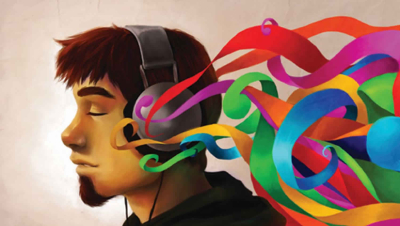
If you ever listen deeply to a song on your headphones and focus intensely, you might sometimes see colours emerging in your mind that align with the songs mood or pace.
The science of perception
Perception is highly variable. As human beings, our range of perception evolved to exclude the nanoscale and macroscale, and we learned to perceive only "medium-sized objects moving at medium speeds". We, as evolutionary organisms, have developed brains that understand only what we need in order to function in the world. And that means our tools of sensory perception are cultivated and specialised according to our domain of operation. We're perception specialists. And specialists can only ever handle a narrow dimension. But here's the good news dimension. But here's the good news: this doesn't have to limit our ability to put our extinction tools of preception to much better use and produce a much more lucid mental model of our reality.
Synaesthesia is the ability of brains to create collaboration between our memories and the sensory regions; here, sights, sounds, colours, tastes, shapes all interact to produce cross-integrated modes of perception – you can hear in colour, taste sights, see sounds, and all that jazz, as per Sussex-University research.
The combinatorial strategy
A well-documented tool of information-processing and storage is Mnemonics a mental tool that help us remember things more easily. Mnemonics employ a similar mechanism to synaesthesia. It works on the same principle of interconnecting concepts and associating new objects with pre-existing memories.
Any higher level of perception and information-processing seems to require a combinatorial strategy. Given that our perception is limited by the bandwidth of our senses, it becomes all the more useful – if not imperative – that we make efforts to increase interaction between the brain's domains and sensory inputs to produce a more cohesive and comprehensive view of the world.
Disinhibited feedback theory
Neurobiologist J. Neufeld believes that the brains of synaesthetes are not much different from that of your everyday friend. But synaesthetic sensations can occur when the barriers between our sensory-processing regions of our brain recede or fall away. In this state of disinhibition, cognitive signals flow more freely between and along our sensory hierarchies and neural pathways. Thus, an optical stimulus (an object or word we see or read) might trigger or bleed into the olfactory (smell-sensing) cortex, producing a sensation of fragrance or odour associated with the word or object.
How does it work?
Synaesthesia is about the interaction between domains of your brain that hitherto worked in isolation. It's collaborative, integrative, interactive. It seems to fortify or strengthen a perception by combining more layers of sensory input in its formation. Like an artist fully recreates a face by accreting dabs of paint of varied shades to define each contour. Like a lump of sugar dissolves fully into a cup of tea to make it sweet. Like you find a joke hilarious because you've processed the punchline simultaneously in two different dimensions of perception the literal, and the ticklish nonsensical – and, therefore, the double-entendre shocks you into laughter.
Picture Credit : Google




